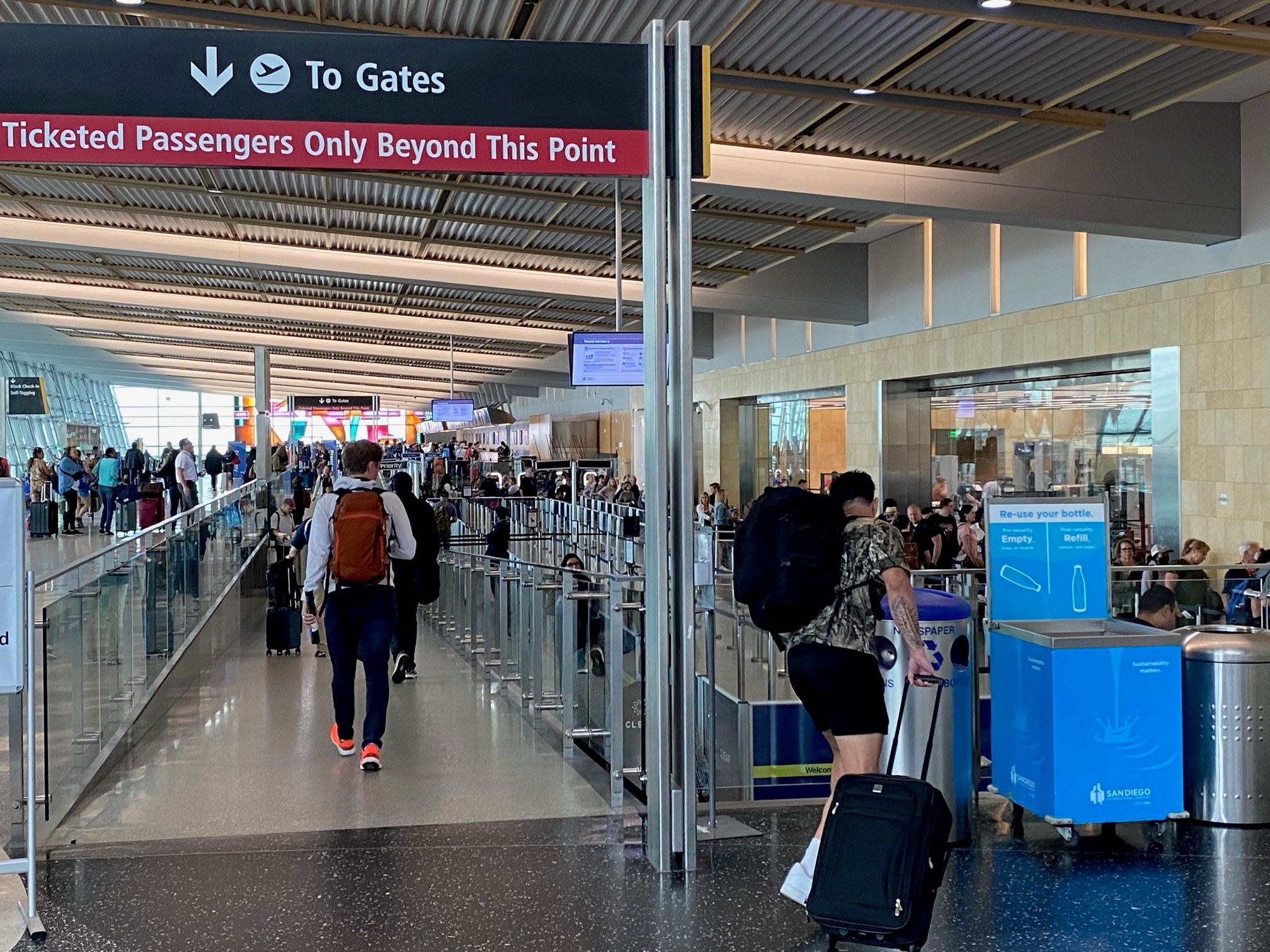
SAN DIEGO - The Transportation Security Administration (TSA) at San Diego International Airport (SAN) is prepared and staffed for what is projected to be a very busy end-of-summer and Labor Day weekend travel surge. With passenger volumes that consistently exceeded 2019 pre-pandemic levels this summer, officials with TSA are encouraging travelers to plan ahead and be prepared every step of the air travel experience.
Since Memorial Day, TSA has screened an average of more than 2.4 million people per day at more than 430 airports nationwide. The Memorial Day and Fourth of July holiday weekends set records for the number of people screened and Labor Day is shaping up to be busy as well. Across the country, TSA expects to screen 14.25 million passengers and crew between Friday, September 1, 2023, and Wednesday, September 6, 2023, which is an 11% increase over last year. Historical national checkpoint screening statistics are available at www.tsa.gov/travel/passenger-volumes.
At SAN, TSA has screened more than 3.79 million departing travelers since the Memorial Day weekend. This is an 18% increase over 2022 volumes for the same period last year. For anyone departing SAN during the Labor Day travel period, it is guaranteed to be busy.
TSA strongly advises that travelers plan ahead, arrive at the airport early and come prepared to help ensure security operations go smoothly for everyone.
Security checkpoint info
The busiest times at SAN’s security checkpoints are 5:00 a.m. to 7:00 a.m., 9:00 a.m. to 1:00 p.m., and again 7:00 p.m. to 9:00 p.m. The busiest days to travel are Thursdays and Fridays as well as Sundays and Mondays.
“The TSA team at SAN has been dedicated to screening residents and visitors departing the airport every day this summer, ensuring that we deliver the most effective security operation in the most efficient manner,” said TSA Federal Security Director at SAN Kathleen Connon. “Despite sustained high volumes of travelers coming to the checkpoint, we maintained our focus on security while screening one passenger, one bag at a time. Kudos to the entire workforce for their commitment to the mission this summer and always.”
Changes to TSA PreCheck® screening
TSA PreCheck expedites a traveler’s airport security checkpoint screening process and allows travelers to leave on their shoes, light outerwear and belt, keep their laptop in its case and their travel size liquids, gels and aerosols in a carry-on. More than 16 million people nationwide have enrolled in TSA PreCheck and regularly enjoy the expedited screening process when they travel.
Previously, children 12 and under have been permitted to use the TSA PreCheck lane when traveling with an eligible parent or guardian on the same itinerary. Starting earlier this summer, teenagers ages 13-17 can now accompany TSA PreCheck enrolled parents or guardians through TSA PreCheck screening when traveling on the same reservation and when the TSA PreCheck indicator appears on the teen’s boarding pass.
On average, 99% of TSA PreCheck-eligible travelers wait 10 minutes or less to be screened through security checkpoints. TSA offers a dedicated TSA PreCheck lanes for travelers departing SAN at each of its checkpoints.
TSA PreCheck enrollment is offered at SAN’s Terminal 2 East, 3707 N. Harbor Drive, San Diego, Calif. The hours are 6 a.m. to 10:30 a.m. and 11 a.m. to 2:30 p.m., Monday to Friday. There are four additional enrollment centers located in San Diego and multiple centers located in the metro area. Start the pre-enrollment process online at www.tsa.gov/precheck.
TSA Cares and Passenger Support Specialists
Through its TSA Cares program, TSA has trained Passenger Support Specialists (PSS) who are TSA officers who have received additional training to provide personalized assistance during the security screening process for travelers with disabilities or special circumstances. Anyone who could benefit from personalized assistance for any reason can contact TSA Cares toll free at 855-787-2227 or by e-mail at TSA-ContactCenter@tsa.dhs.gov.
TSA Cares will forward the traveler's contact information and itinerary to the TSA staff at the airport where the traveler is departing. There is no cost for this service, but it is recommended you contact TSA Cares 72 hours in advance of travel.
For more information on TSA Cares and the PSS program, visit www.tsa.gov/travel/passenger-support.
End-of summer travel tips
Travelers have the ability to impact the efficiency of the airport travel experience. Because there is no substitute for being prepared, TSA recommends the following:
Pack smart. Travelers should be aware of the contents of their carry-on bags prior to leaving home. Ensure that carry-ons do not contain prohibited items since they slow down the security screening process. TSA is reminding all travelers that fireworks don’t fly - in carry-on or checked luggage. Fireworks are never allowed on an aircraft, so please don’t bring them to the airport. In addition, fuel canisters frequently used by campers and other outdoor enthusiasts are flammable and not allowed in carry-on or checked luggage.
To determine whether an item is allowed or prohibited in carry-on luggage, download the MyTSA app and use the “What Can I Bring?” feature. Another option is to snap a picture of an item and send it to @AskTSA on Twitter or Facebook Messenger for real-time assistance. Travelers can also send a question by texting “Travel” to AskTSA (275-872).
Wear shoes that are easy to remove and put back on. Shoes that lace up and extend up your leg will slow you down. Slip-on shoes are best. And, do yourself a favor: wear socks!
Use your time wisely in the security checkpoint queue. Have your photo ID ready. Don’t wait until you approach the TSA officer who is checking IDs to look for it. Empty your pockets prior to arrival in the checkpoint. Place wallets, phones, keys, sunglasses and other loose items from your pockets inside your carry-on bag instead of placing them in a bin. This will ensure personal items are not left behind.
Listen for guidance from TSA officers. Whether you travel regularly or infrequently, it is important to listen to the direction provided in the security checkpoint. SAN has security screening technologies in use that may allow travelers not to present a boarding pass during the travel document checking process or leave all items in their carry-on luggage as it is screened through the X-ray unit. Listen up – it may make for a more streamlined, convenient and time-saving passenger experience.
Follow the rule for traveling with liquids. Sunscreen, creams, bug spray and other liquids and aerosols are limited to 3.4 ounces (100 ml) or less in carry-on luggage. If a traveler brings liquids in quantities larger than 3.4 ounces, TSA will have to conduct a bag check, which slows the screening process for that traveler and everyone in line behind them. Any liquids in quantities larger than 3.4 ounces should travel in checked baggage.
Eligible for TSA PreCheck? Enter your Known Traveler Number (KTN). Be sure that your airline reservation has your correct KTN and date of birth so you can “Travel with Ease.” Those who fly with multiple airlines should ensure their KTN is updated in each of their airline profiles every time you travel. TSA offers the TSA PreCheck experience at every airport nationwide, so this is a guaranteed way to save time and have a more convenient experience.
Do not joke about having an explosive device. Stating the obvious, don’t claim that you’ve have a bomb with you. The next thing you know, you will have a serious conversation with airport law enforcement, likely miss your flight and potentially much worse!

